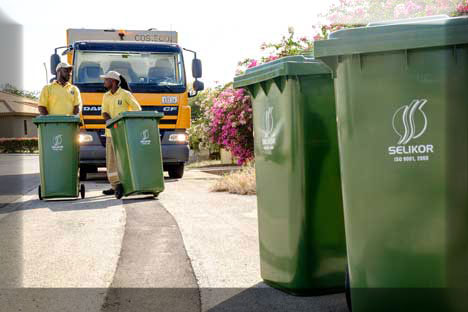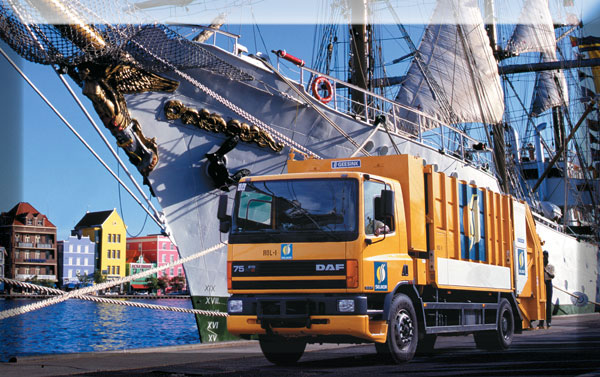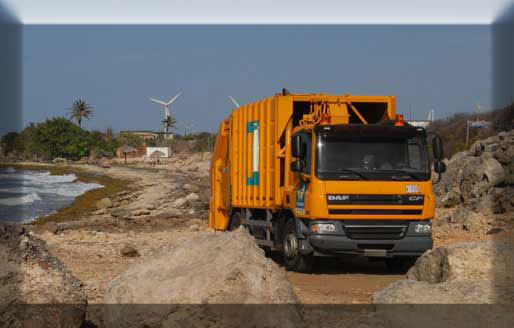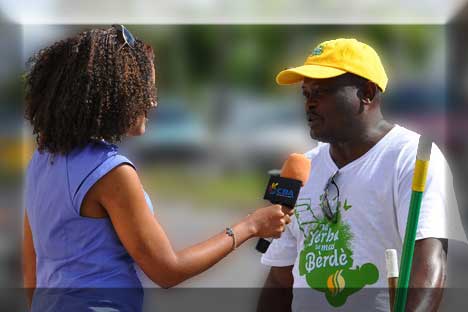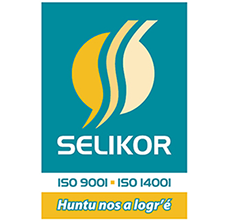
Several years ago the Caribbean island of Curaçao could not imagine the high level of waste that it has today. Through the years Selikor NV has grown from a government waste collection department to the largest and most experienced waste management company on the island of Curaçao, using the most modern equipment and facilities in the Caribbean.
The first major advancement Selikor made on Curaçao was in the collection and transportation of waste. For many years, waste collection on Curaçao took place by means of 55-gallon drums. On collection day the drums were manually lifted by the garbage collector and emptied into a big truck for transportation.
Since 1996 waste collection has taken place using wheeled plastic containers. These containers are mechanically emptied into a state-of-the-art garbage truck. With this method the collection efficiency increased substantially and collection is now much more hygienic. An added value of this method is that the garbage collectors were relieved of the strenuous task of lifting heavy drums.
The second major development was in waste disposal. In the past, ocean dumping was a normal procedure for disposal of solid waste. Sanitary landfills were not used. The current situation is one with a well-structured sanitary landfill at which advanced equipment is used to compact and cover the waste disposed on a daily basis.
Furthermore Curaçao has at its disposition a waste transfer station, which is used as an intermediary waste depot. The main purpose of this depot is to save time in transportation and to function more efficiently. At this transfer station 2 silos and 2 compactors are situated. When the silos and the compactors are full they are transported to and emptied at the landfill.
History of Waste Management on the Island of Curaçao
For many years on Curaçao there were some misconceptions concerning waste management. The common opinion was that managing waste is simple and easy and everybody tried to do it on their own. All types of garbage were mixed together and thrown in drums or transported to the landfill in pick-up trucks. People were not aware of the waste processing and treatment options that existed. The opinion was that all types of waste management cost the same and there was no awareness that some waste management methods can save substantial costs. Some of these misconceptions still live on.
Nevertheless on Curaçao we have realized that modern waste management is a complex technical industry that requires a professional and integrated approach. Managing waste the old fashioned way costs more time, labor, and money. More importantly, managing waste the old fashioned way may end up contaminating the environment and damaging natural resources.
There are many types of waste such as construction, chemical, medical, and liquid waste and each type of waste needs to be managed differently employing state-of-the-art techniques. Modern waste management techniques are more hygienic, efficient, safer, and environmentally friendlier. But more importantly, modern techniques make waste management easy and, in the long run, less expensive.
History has taught us a lot and we are still putting these lessons in practice. On Curaçao, waste management has been continuously developing and moving towards professionalism. Because in this modern world, you cannot afford to continue solving advanced problems with amateur, outdated approaches.
Selikor's History Timeline
- 1974: Selikor - “Servisio di Limpiesa Kòrsou” - is installed as an independent government agency
- 1975: Koral Specht landfill opened
- 1983: Plastic garbage bags for residential waste were introduced
- 1985: Malpais landfill opened
- 1989: Koral Specht landfill closed
- 1990: Residential and commercial waste collected separately
- 1990: Koral Specht transfer station opened
- 1995: The first Waste Management Plan for Curaçao was approved
- 1996: Selikor was founded as a private limited liability company
- 1996: Residential waste containers were introduced
- 1996: Curaçao’s first solid and chemical waste law passed
- 1996: Formulation of business plan 1996-2000
- 1996: Curaçao’s first waste tax law was passed
- 1997: Variety of commercial waste containers were introduced
- 1997: Stationary commercial waste compactors were introduced
- 1999: Caribbean Recycling Company NV (CRC) was established with Selikor as a shareholder
- 1999: Automated operational software ‘CLEAR’ was implemented
- 1999: The first year of positive financial results for Selikor
- 2000: Start of Waste Management Consultancy (WMC) with the first project on the Netherlands Antilles Winward islands
- 2001: ISO 9000-2001 quality certificate was obtained
- 2001: Waste glass collection containers were introduced
- 2003: Curaçao Incineration Company NV (CIC) was established with Selikor as the majority shareholder
- 2003: Crusher for construction and demolition waste became operational at the CRC
- 2004: Selikor’s new head office was constructed
- 2005: Proclaimed as Clean-up Year
- 2005: ISO 14001 environmental certificate was obtained
- 2005: Celebration of the 10th anniversary of Selikor NV
- 2005: Opening of the new head office at Parera
- 2006: Formulation of business plan 2007-2010
- 2007: New Managing Director was appointed
- 2008: Performance Management was reintroduced
- 2008: Community Project: Spelling Bee contest “Di Lèter pa Palabra”
- 2008: Ban on use of plastic bags in supermarkets and promotion of reusable shopping/grocery bags
- 2009: Electronic complaint registration and handling system was introduced
- 2009: Preparations initiated for construction of a new Maintenance Facility for Selikor’s vehicles
- 2009: Preparations initiated for the construction of Selikor’s new Waste Drop-off Center and Materials Recovery Facility
- 2010: Celebration of the 15th anniversary of Selikor NV
- 2010: Opening of Selikor’s Waste Drop-off Center at Malpais Landfill
- 2011: Partnership with Fun Miles promotion of disposing recyclable waste
- 2012: Developing of internal information system "START"
- 2012: Implementation of a new job evaluation and performance system
- 2012: Launching of Selikor’s KLIKO mascot “Grunchi”
- 2013: Selikor acquires 100% shares from CRC


